Or – “Right On With The NOW Superhero! Only Now Has Become THEN…”
The 1970’s were a truly odd time for comics. After the revolutionary sixties, many comic books reverted to old Silver Age tricks while others tried to push the envelope with nudity, violence and casual drug use. Not content to leave any road less traveled, Skywald Publications chose to take both approaches…
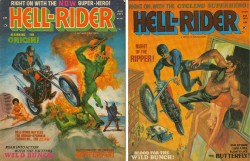 HELL-RIDER #1 & #2
HELL-RIDER #1 & #2
Scripter: Gary Friedrich
Penciler(s): Ross Andru/Dick Ayers/Syd Shores/Rich Buckler
Inker: Mike Esposito
Cover Artist: Harry Rosenbaum
Letterer: Uncredited
Editor: Lou Mougin
Publisher: Skywald Publications
Cover Price: 60 Cents (Current Near-Mint Pricing: $75/$50)
Previously, on Hell-Rider: Skywald Publications was a joint venture of Sol Brodsky (a long-time production manager at Marvel Comics) and Israel Waldman, whose Super Comics imprint is remembered mostly for reprinting comics that they didn’t actually have the rights to. Known mostly for their horror magazines (Nightmare, Psycho and Scream) that competed mostly with Warren’s black-and-whites, they also brought back Golden Age character The Heap and ran a few short-lived color comics as well. But far and away the most coveted jewel in the Skywald collector’s crown is the adventures of The Hell-Rider. As was the custom in the Bronze Age of comics, we kick things off in media res, with Hell-Rider already in the midst of his first adventure. Like most noir stories, it all starts with a girl…
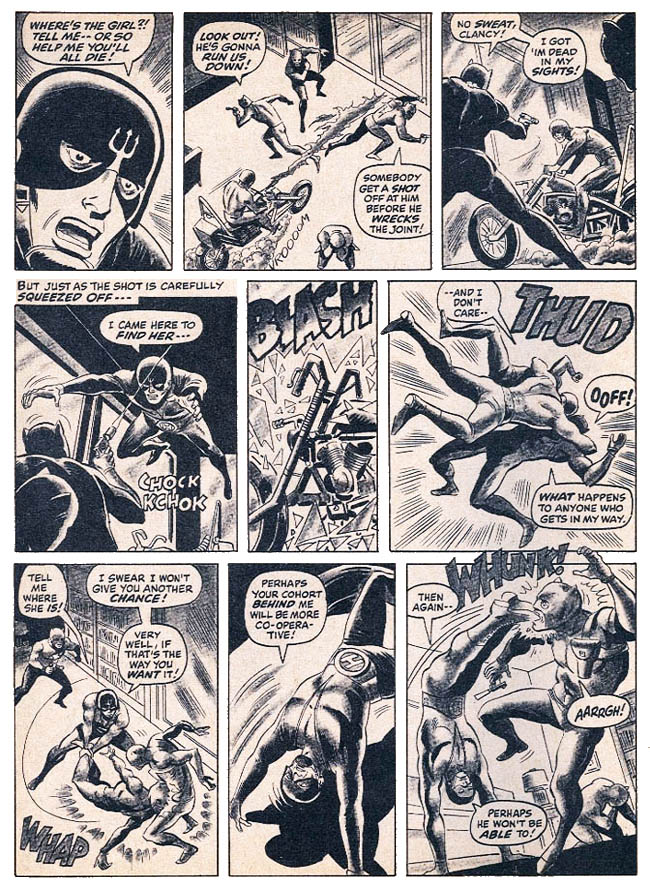 He’s like a motorcycle ninja, only with mod dialogue and a shirt cut down to the navel, for some reason. When copies of this book showed up at Gatekeeper Hobbies (Huntoon and Gage, Topeka! Ask us about our Ebay store!) a few months ago, manager Deon asked me if the character was anything more than a Ghost Rider knockoff. In point of fact, Hell-Rider’s adventures are pretty much the prototype for the Johnny Blaze to come, as these magazines predate Marvel Spotlight #5 by almost a year, and are not coincidentally penned by Ghost Rider creator Gary Friedrich! For all his acrobatic prowess, Hell-Rider can still be downed by a blow to the head (another Silver and Bronze Age staple), which leaves him in the clutches of the villainous Claw…
He’s like a motorcycle ninja, only with mod dialogue and a shirt cut down to the navel, for some reason. When copies of this book showed up at Gatekeeper Hobbies (Huntoon and Gage, Topeka! Ask us about our Ebay store!) a few months ago, manager Deon asked me if the character was anything more than a Ghost Rider knockoff. In point of fact, Hell-Rider’s adventures are pretty much the prototype for the Johnny Blaze to come, as these magazines predate Marvel Spotlight #5 by almost a year, and are not coincidentally penned by Ghost Rider creator Gary Friedrich! For all his acrobatic prowess, Hell-Rider can still be downed by a blow to the head (another Silver and Bronze Age staple), which leaves him in the clutches of the villainous Claw…
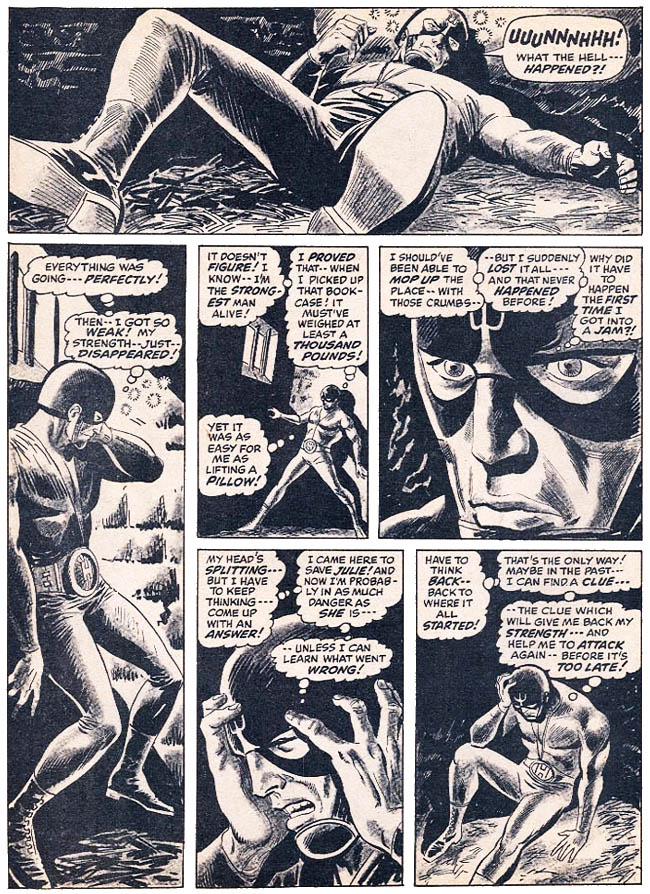 I really admire how Friedrich manages to work the character’s history into the story naturalistically, with Hell-Rider trying to shake off a concussion by reviewing what he knows, starting with his graduation from law school a few months earlier. When rich lawyer daddy offers him a seat at his table, the nascent Hell-Rider (secretly Brick Reese, a name almost as cool as Johnny Blaze) went off on a journey to find himself, which somehow ended up, as all 70’s journeys seemed to, in a bar fight.
I really admire how Friedrich manages to work the character’s history into the story naturalistically, with Hell-Rider trying to shake off a concussion by reviewing what he knows, starting with his graduation from law school a few months earlier. When rich lawyer daddy offers him a seat at his table, the nascent Hell-Rider (secretly Brick Reese, a name almost as cool as Johnny Blaze) went off on a journey to find himself, which somehow ended up, as all 70’s journeys seemed to, in a bar fight.
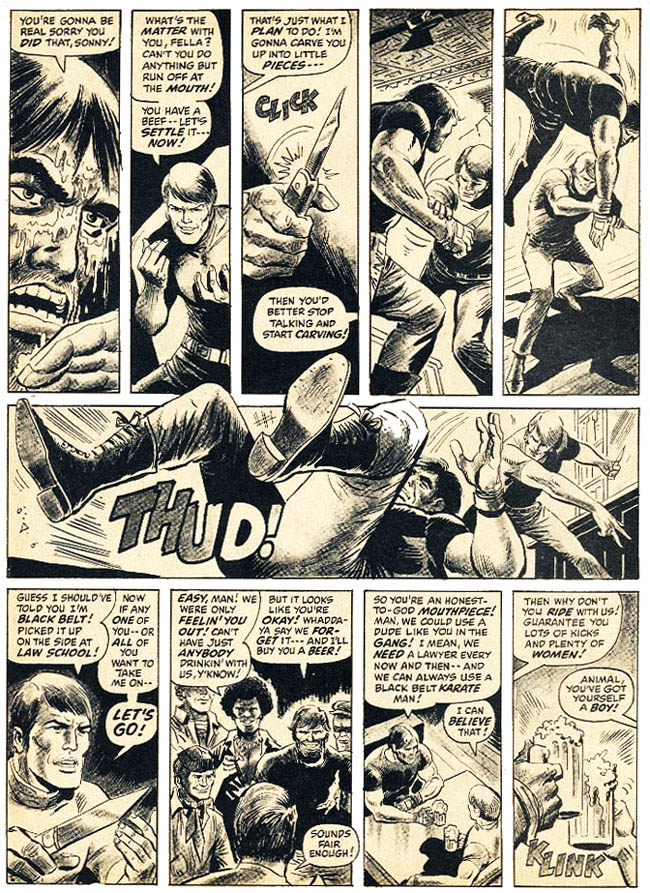 The rich, cultured black belt lawyer ends up riding with the rough-hewn biker gang for months, living the wild life in the streets, a lost weekend that only ended when he was drafted to Vietnam. After a year-long tour, Brick was severely injured in combat, leading him to add another layer to his biker/lawyer/ninja/veteran mashup: Super-soldier.
The rich, cultured black belt lawyer ends up riding with the rough-hewn biker gang for months, living the wild life in the streets, a lost weekend that only ended when he was drafted to Vietnam. After a year-long tour, Brick was severely injured in combat, leading him to add another layer to his biker/lawyer/ninja/veteran mashup: Super-soldier.
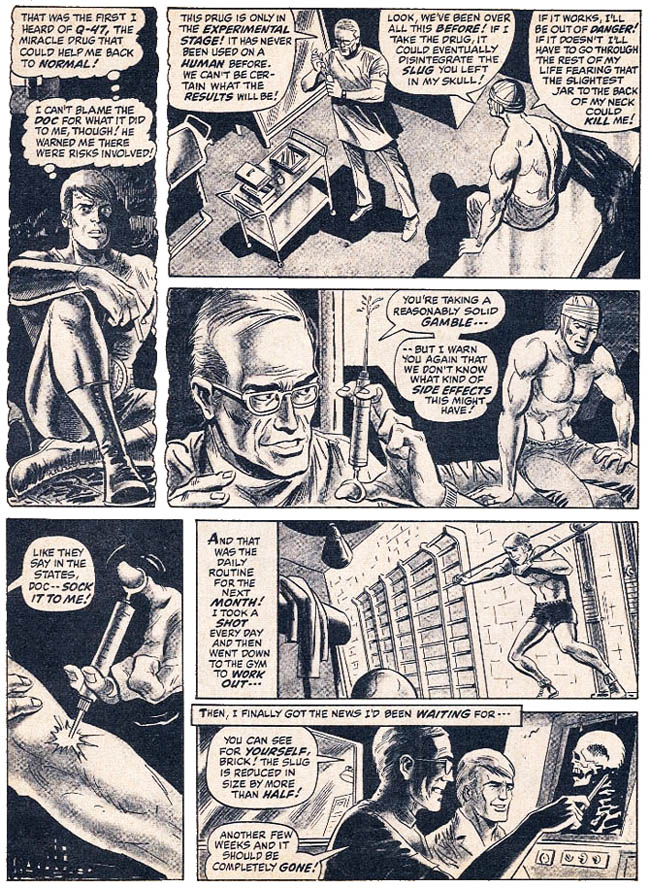 The drug not only dissolved the bullet in his spine, it gave him super-strength and endurance. In a lovely topical reference, he remarks that Bruno Sammartino, former WWWF Heavyweight Champion, couldn’t do what he just did. The editors make a point early in this issue to remind us that Hell-Rider is the “NOW Superhero” and have chose many elements to hammer home his more ‘realistic’ stories. The Claw is no mere super-villain, but a heroin dealer. Brick isn’t just a super-duper, but a Vietnam vet. And as for Brick’s home life, he uses his money to do what many of us would do: Live the high life surrounded by nearly-naked beautiful people.
The drug not only dissolved the bullet in his spine, it gave him super-strength and endurance. In a lovely topical reference, he remarks that Bruno Sammartino, former WWWF Heavyweight Champion, couldn’t do what he just did. The editors make a point early in this issue to remind us that Hell-Rider is the “NOW Superhero” and have chose many elements to hammer home his more ‘realistic’ stories. The Claw is no mere super-villain, but a heroin dealer. Brick isn’t just a super-duper, but a Vietnam vet. And as for Brick’s home life, he uses his money to do what many of us would do: Live the high life surrounded by nearly-naked beautiful people.
 I also love that he was able to buy a beachfront party house for 25,000 bucks. These two issues are full of barely covered young ladies who still manage to look like they’re stepping off the cover of a romance comic from 1958 rather than a key party in the swingin’ 70’s, including Julie Storm, she of the kicking-off-the-adventure and the name-like-a-porn-star. Having run through his funds, Brick returns to law at his uncle’s much smaller firm, and ends up being tasked with taking care of Julie, an up-and-coming young rock star who just kicked a heroin addiction. This ticks off The Claw, who sends his costumed goons (for some reason) to abduct her and register his displeasure with losing her as clientele…
I also love that he was able to buy a beachfront party house for 25,000 bucks. These two issues are full of barely covered young ladies who still manage to look like they’re stepping off the cover of a romance comic from 1958 rather than a key party in the swingin’ 70’s, including Julie Storm, she of the kicking-off-the-adventure and the name-like-a-porn-star. Having run through his funds, Brick returns to law at his uncle’s much smaller firm, and ends up being tasked with taking care of Julie, an up-and-coming young rock star who just kicked a heroin addiction. This ticks off The Claw, who sends his costumed goons (for some reason) to abduct her and register his displeasure with losing her as clientele…
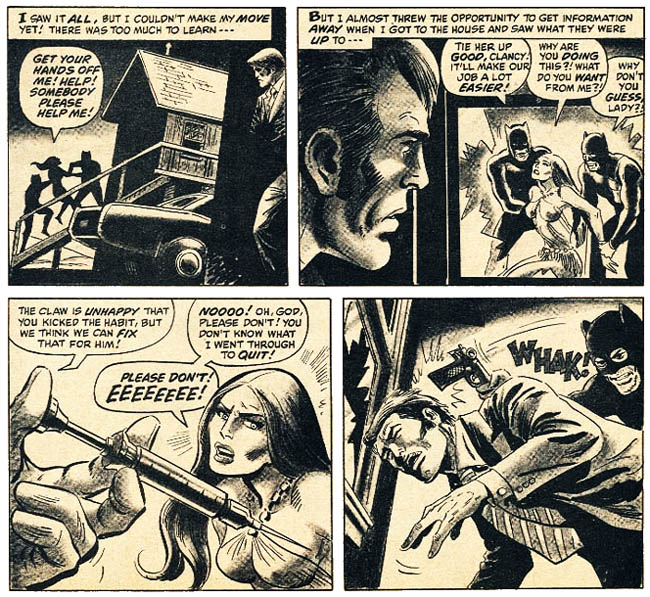 That is Brick’s second shot to the head in this issue (albeit the first one chronologically) and leads us to Brick’s fateful decision. To save Julie, he customizes his leathers, mounts weaponry on his beloved Harley, and decides to become a super-hero! “I oughta make one hell of a splash on the scene… In fact, that’s what I’ll call myself… The Hell-Rider!” As names go, we’ve heard much worse, honestly. Chapter one of the story ends with Brick brooding in the Claw’s dungeon about what a terrible superhero he has become. Chapter two concerns another of Brick’s clients, Marian Michaels, who is being blackmailed over a particular pair of boots. Marian is also visited by the Claw’s goons, but she manages to get away by revealing herself to be another superhero, this one the glamorous Butterfly!
That is Brick’s second shot to the head in this issue (albeit the first one chronologically) and leads us to Brick’s fateful decision. To save Julie, he customizes his leathers, mounts weaponry on his beloved Harley, and decides to become a super-hero! “I oughta make one hell of a splash on the scene… In fact, that’s what I’ll call myself… The Hell-Rider!” As names go, we’ve heard much worse, honestly. Chapter one of the story ends with Brick brooding in the Claw’s dungeon about what a terrible superhero he has become. Chapter two concerns another of Brick’s clients, Marian Michaels, who is being blackmailed over a particular pair of boots. Marian is also visited by the Claw’s goons, but she manages to get away by revealing herself to be another superhero, this one the glamorous Butterfly!
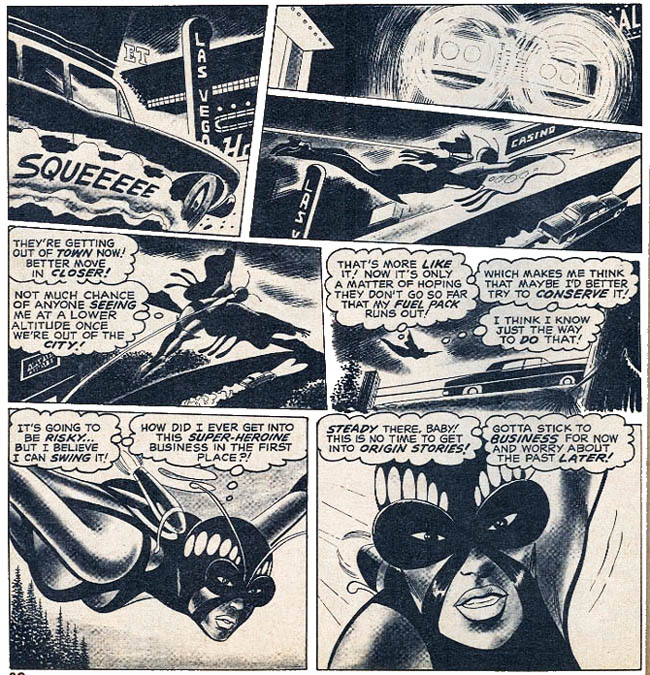 I have to love the genre-savviness of the whole ‘no time for origin stories’ bit, there. Butterfly gets back her special boots (though she still doesn’t why they want them) but suffers a particularly unpleasant Spider-Man moment when her jetpacks run out of fuel before she makes it back to Vegas. Setting off to hitchhike home, she ends up crossing paths with… Brick’s old biker gang, The Wild Bunch!
I have to love the genre-savviness of the whole ‘no time for origin stories’ bit, there. Butterfly gets back her special boots (though she still doesn’t why they want them) but suffers a particularly unpleasant Spider-Man moment when her jetpacks run out of fuel before she makes it back to Vegas. Setting off to hitchhike home, she ends up crossing paths with… Brick’s old biker gang, The Wild Bunch!
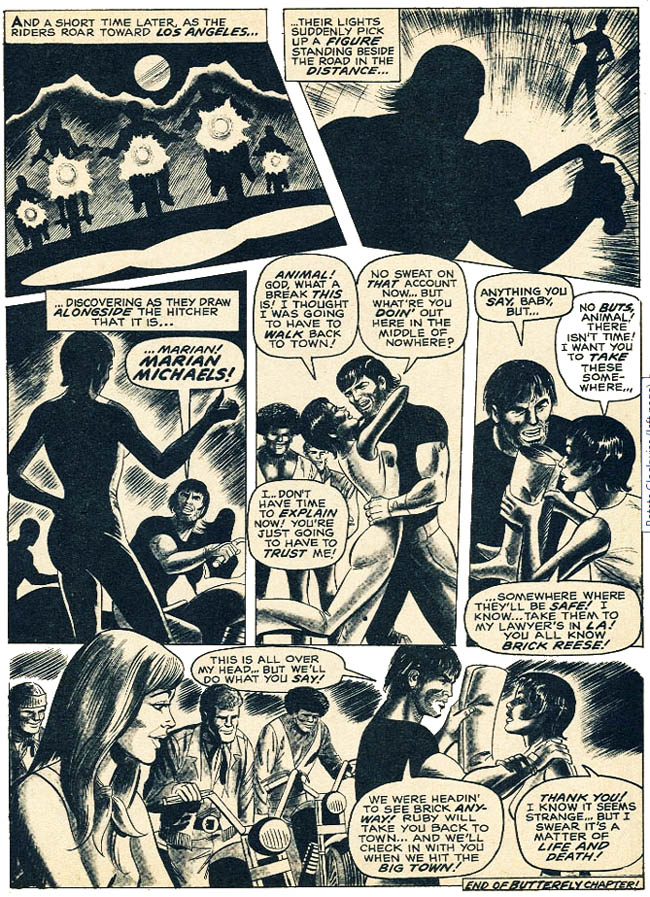 Animal, Deke, Slinker, Curly and Ruby give Marian/Butterfly a ride back, and we get yet another super-70’s cheesecake moment when Ruby and Marian make it back to the hotel. We also find that the boots were a gift from Julie Storm, and that in the 1970’s, it was perfectly normal to strip in front of a woman you just met.
Animal, Deke, Slinker, Curly and Ruby give Marian/Butterfly a ride back, and we get yet another super-70’s cheesecake moment when Ruby and Marian make it back to the hotel. We also find that the boots were a gift from Julie Storm, and that in the 1970’s, it was perfectly normal to strip in front of a woman you just met.
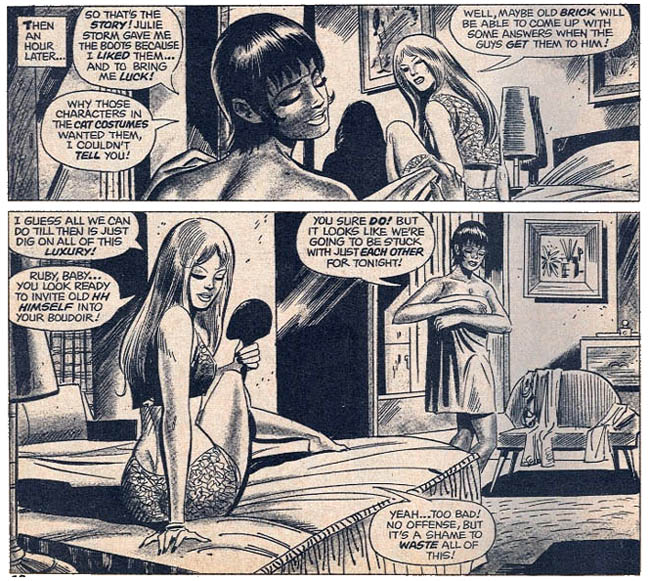 Had this been a 90’s-era book, we would have probably seen a makeout session between Ruby and Butterfly here, so it could have been worse. Or perhaps better. But at least different… I’m not entirely sure if Dick Ayers or Syd Shores is handling the art here (or perhaps Rich Buckler doing an impersonation of one or both) but it’s a lot more detailed and lush than many of the color books of the period. And while Butterfly and the Wild Bunch were out on their footwear-related mission, Hell-Rider’s super-strength returns and he goes all Batman through a skylight!
Had this been a 90’s-era book, we would have probably seen a makeout session between Ruby and Butterfly here, so it could have been worse. Or perhaps better. But at least different… I’m not entirely sure if Dick Ayers or Syd Shores is handling the art here (or perhaps Rich Buckler doing an impersonation of one or both) but it’s a lot more detailed and lush than many of the color books of the period. And while Butterfly and the Wild Bunch were out on their footwear-related mission, Hell-Rider’s super-strength returns and he goes all Batman through a skylight!
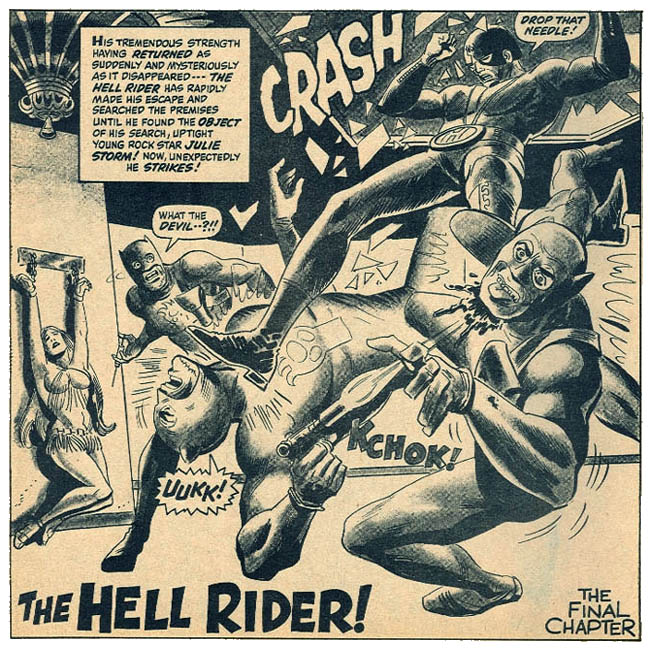 I think that belt means he’s the World Champion of ninja/lawyer/biker/soldiers. Helly manages to get Julie away from the Claw’s minions and to an E.R., where an angry doctor blames him for her troubles (more shades of Spider-Man.) Marian and Ruby discover a hidden stash of drugs hidden in the boots, and Hell-Rider arrives just in time to keep the gang members from being murdered for the precious stash of China White…
I think that belt means he’s the World Champion of ninja/lawyer/biker/soldiers. Helly manages to get Julie away from the Claw’s minions and to an E.R., where an angry doctor blames him for her troubles (more shades of Spider-Man.) Marian and Ruby discover a hidden stash of drugs hidden in the boots, and Hell-Rider arrives just in time to keep the gang members from being murdered for the precious stash of China White…
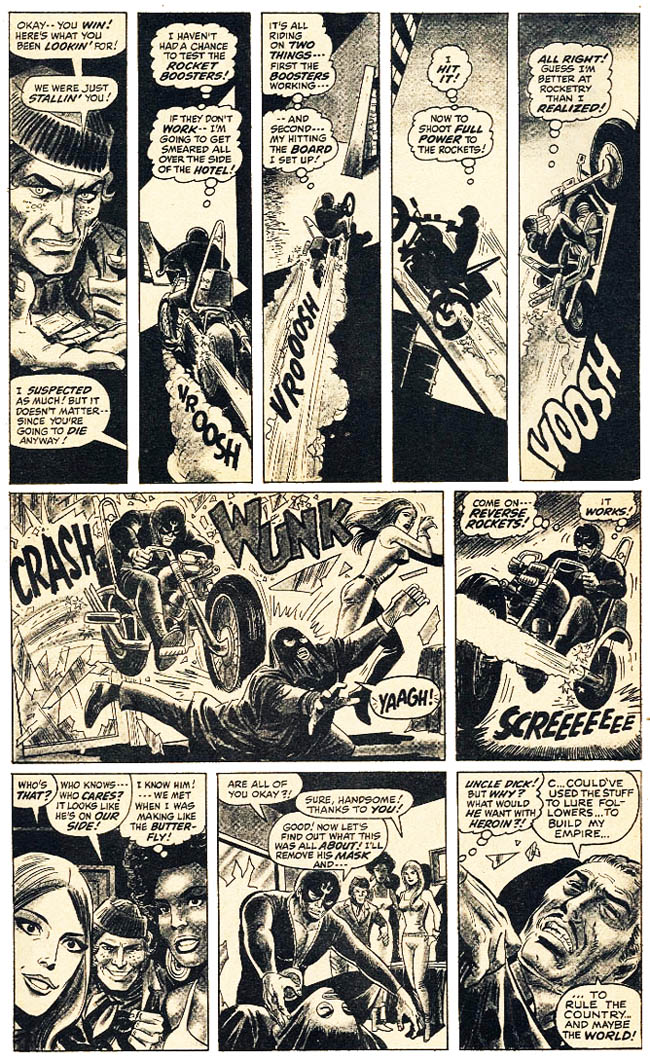 So, a plan that coincidentally involved Brick, his former cronies in the biker gang, his Vegas singer pal (who is coincidentally also a hero whom he knows in his costumed identity) was also coincidentally run by his own uncle? That’s… interesting. Makes you wonder why a successful attorney would get involved in drug running, or even where he found the time. We also don’t examine why his friends don’t recognize him half-naked wearing a helmet, but that’s more of a superhero trope than any failing with this book. Crushing the villain’s spine with a rushing motorcycle, on the other hand, is totally “NOW.” Issue #2 begins with a recap of #1, the revelation that Julie is in an irreversible drug-induced coma, and then throws us straight into a pastiche of ‘Dr. Jekyll and Mr. Hyde.’
So, a plan that coincidentally involved Brick, his former cronies in the biker gang, his Vegas singer pal (who is coincidentally also a hero whom he knows in his costumed identity) was also coincidentally run by his own uncle? That’s… interesting. Makes you wonder why a successful attorney would get involved in drug running, or even where he found the time. We also don’t examine why his friends don’t recognize him half-naked wearing a helmet, but that’s more of a superhero trope than any failing with this book. Crushing the villain’s spine with a rushing motorcycle, on the other hand, is totally “NOW.” Issue #2 begins with a recap of #1, the revelation that Julie is in an irreversible drug-induced coma, and then throws us straight into a pastiche of ‘Dr. Jekyll and Mr. Hyde.’
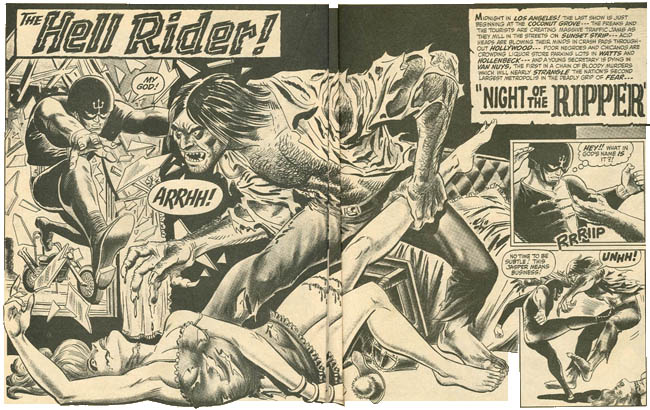 Hell-Rider had stopped by his secretary’s apartment, ostensibly to pick up some paperwork (although neither of them is really dressed for it) and finds the monster in the midst of killing her. After he takes a beating, Brick decides to retire Hell-Rider for good. He is then called (coincidentally, one might say) by his old friend Selwyn Samuels, who is pretty much a low-rent Hugh Hefner. The obligatory half-dressed women appear, and we find that Selwyn wants to sample and test the miracle drug that healed Brick back in the ‘Nam. Selwyn sends Brick off to entertain himself in the company of Selwyn’s brother, Jack…
Hell-Rider had stopped by his secretary’s apartment, ostensibly to pick up some paperwork (although neither of them is really dressed for it) and finds the monster in the midst of killing her. After he takes a beating, Brick decides to retire Hell-Rider for good. He is then called (coincidentally, one might say) by his old friend Selwyn Samuels, who is pretty much a low-rent Hugh Hefner. The obligatory half-dressed women appear, and we find that Selwyn wants to sample and test the miracle drug that healed Brick back in the ‘Nam. Selwyn sends Brick off to entertain himself in the company of Selwyn’s brother, Jack…
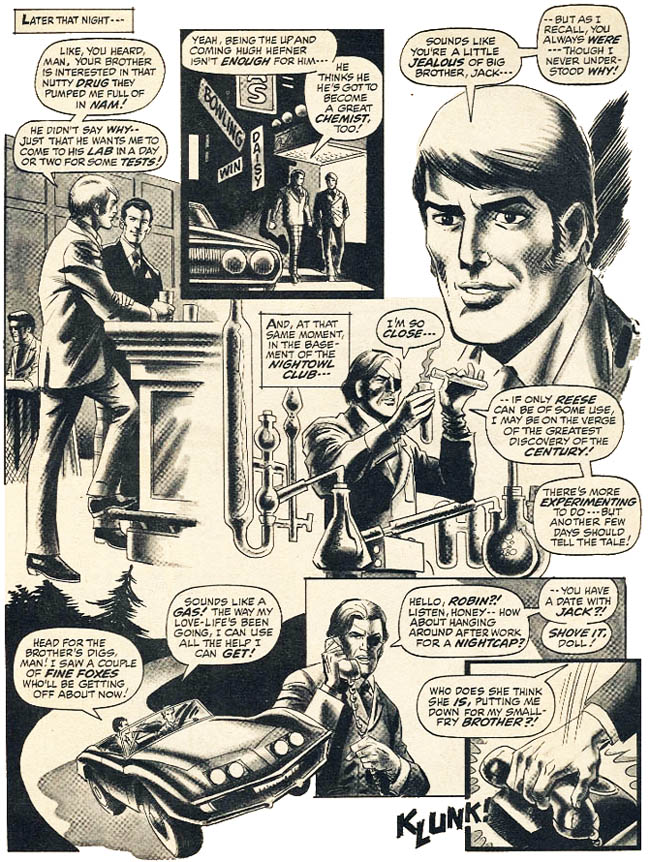 Oh, this isn’t going to end well. True to form, the girl that the brothers are both vying for ends up dead at the hands of the monstrous Ripper (after appearing extensively in her underwear.) The next morning, Brick finds out that there have been FOUR total killings, including his secretary, and all of them have some sort of tie to Selwyn Samuels, who also wants to extract and duplicate the chemicals in Hell-Rider’s bloodstream, to create his own army of superhumans…
Oh, this isn’t going to end well. True to form, the girl that the brothers are both vying for ends up dead at the hands of the monstrous Ripper (after appearing extensively in her underwear.) The next morning, Brick finds out that there have been FOUR total killings, including his secretary, and all of them have some sort of tie to Selwyn Samuels, who also wants to extract and duplicate the chemicals in Hell-Rider’s bloodstream, to create his own army of superhumans…
 I like that there is absolutely no reason (other than eye candy) to feature that nearly-topless young lady in such a key position of this page. Also, I find it suspect that a chemist who wants to create super-powers is being stalked by a mysterious super-powered being, almost as if there’s something else going on here. Hmmmm…. Another murder takes place that night, causing Brick to once again don the garb of Hell-Rider in search of a murderer. It does not go so well…
I like that there is absolutely no reason (other than eye candy) to feature that nearly-topless young lady in such a key position of this page. Also, I find it suspect that a chemist who wants to create super-powers is being stalked by a mysterious super-powered being, almost as if there’s something else going on here. Hmmmm…. Another murder takes place that night, causing Brick to once again don the garb of Hell-Rider in search of a murderer. It does not go so well…
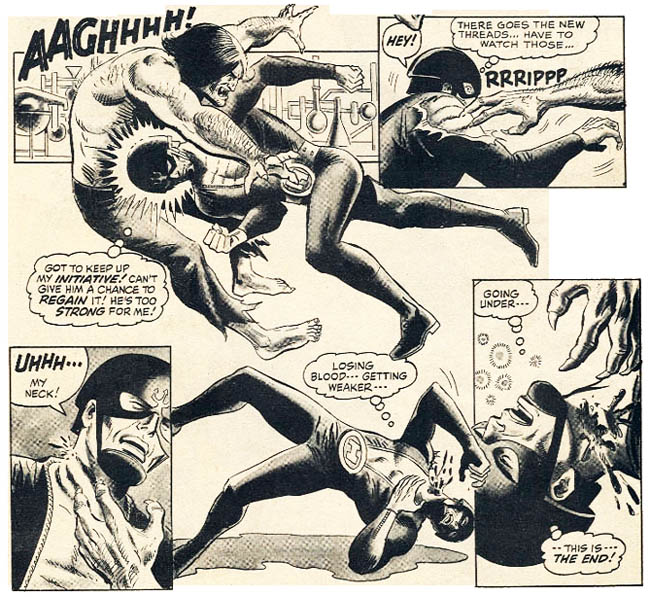 Hell-Rider awakens some time later to find the monster gone, and Jack Samuels patching up his severed carotid artery. Because that probably wouldn’t have been fatal or anything… A second bout with The Ripper goes much better for Hell-Rider, who bails out before the monster returns to human form, happy to have kept Selwyn Samuels from murdering another innocent woman.
Hell-Rider awakens some time later to find the monster gone, and Jack Samuels patching up his severed carotid artery. Because that probably wouldn’t have been fatal or anything… A second bout with The Ripper goes much better for Hell-Rider, who bails out before the monster returns to human form, happy to have kept Selwyn Samuels from murdering another innocent woman.
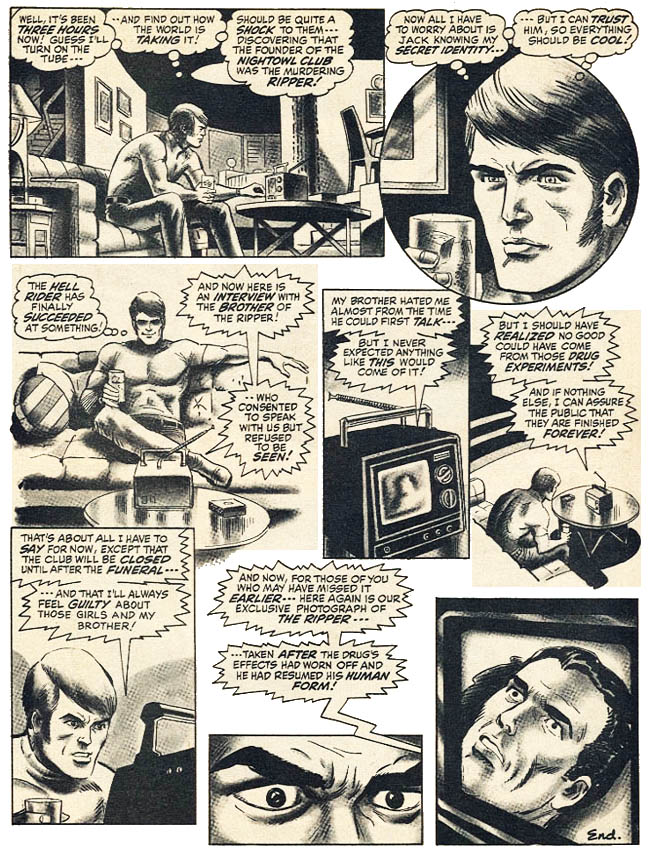 Well, at least he doesn’t have to worry about anyone knowing his secret identity. For all the oh-so-70’s moments, the last three panels here are very powerful work from artist Ross Andru, best known for his work on Spider-Man and Wonder Woman. The issue continues with the Wild Bunch in action (notable mostly for an extended sequence of Ruby in a bikini) and a Butterfly-fights-the-KKK story that is pretty much pure 70’s Marvel. In the final story of the issue, after a difficult series of battles ending in not one, but TWO close friends being super-villains, Brick takes a relaxing drive along the Mexican coastline. Which, of course, leads to him being kidnapped by a human trafficking ring… y’know, like these things often do.
Well, at least he doesn’t have to worry about anyone knowing his secret identity. For all the oh-so-70’s moments, the last three panels here are very powerful work from artist Ross Andru, best known for his work on Spider-Man and Wonder Woman. The issue continues with the Wild Bunch in action (notable mostly for an extended sequence of Ruby in a bikini) and a Butterfly-fights-the-KKK story that is pretty much pure 70’s Marvel. In the final story of the issue, after a difficult series of battles ending in not one, but TWO close friends being super-villains, Brick takes a relaxing drive along the Mexican coastline. Which, of course, leads to him being kidnapped by a human trafficking ring… y’know, like these things often do.
 The girl quickly strips, for some reason, but Brick’s super-strength allows them to escape (while immediately fading in mid-fight, a somewhat annoying shortcut to try and keep the main character approachable, in my eyes) and stashing the girl in his hotel room, while he sets out to right wrongs as Hell-Rider, biker guardian of justice and such. Last issue, Hell-Rider landed his bike on the villain, probably leading to paralysis had the impact not killed him. This issue, he takes a gentler approach…
The girl quickly strips, for some reason, but Brick’s super-strength allows them to escape (while immediately fading in mid-fight, a somewhat annoying shortcut to try and keep the main character approachable, in my eyes) and stashing the girl in his hotel room, while he sets out to right wrongs as Hell-Rider, biker guardian of justice and such. Last issue, Hell-Rider landed his bike on the villain, probably leading to paralysis had the impact not killed him. This issue, he takes a gentler approach…
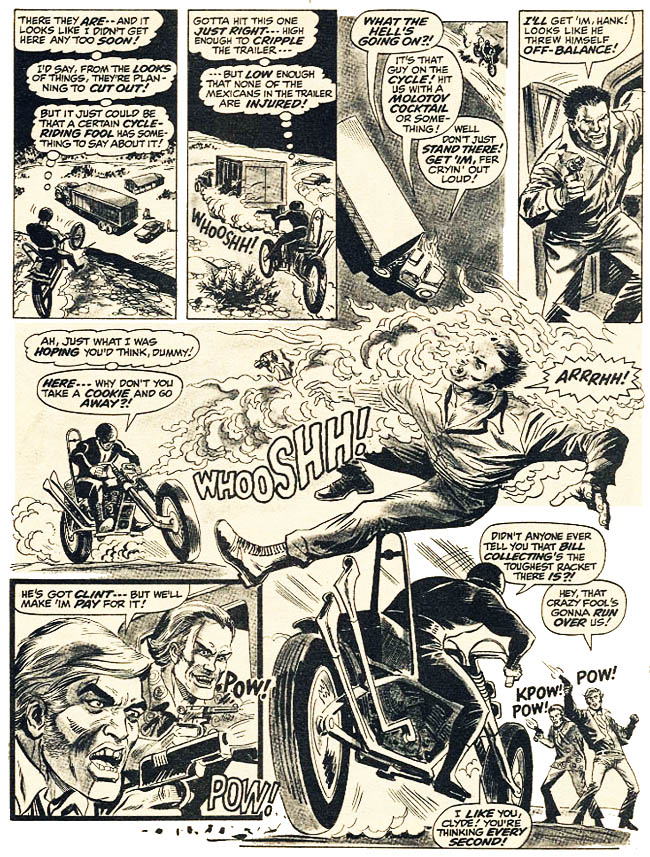 …BY SETTING THE VILLAIN ON FIRE. This is, after all, a more realistic comic take on the superhero, which inevitably leads to fatalities (if you believe Frank Miller, anyway.) After going all kung-fu biker on the rest of the gang (and it is a pretty impressive sequence, as Andru can draw a mean, if not particularly realistic, motorcycle), Hell-Rider gets knocked off his hog, and is forced to grab a gun for defense. A thug tries to get the drop on him, but Brick shoots the man… in the face. The ultra-violence is jarring, even in a book filled with nigh-nekkid female flesh and heroin runners and such, but his method of taking out the gang’s leader is pure comics schlock.
…BY SETTING THE VILLAIN ON FIRE. This is, after all, a more realistic comic take on the superhero, which inevitably leads to fatalities (if you believe Frank Miller, anyway.) After going all kung-fu biker on the rest of the gang (and it is a pretty impressive sequence, as Andru can draw a mean, if not particularly realistic, motorcycle), Hell-Rider gets knocked off his hog, and is forced to grab a gun for defense. A thug tries to get the drop on him, but Brick shoots the man… in the face. The ultra-violence is jarring, even in a book filled with nigh-nekkid female flesh and heroin runners and such, but his method of taking out the gang’s leader is pure comics schlock.
 It’s a pretty upbeat ending, considering that he has smuggled a woman into the United States illegally for sexual congress after murdering at least five men in cold blood. Hell-Rider first came to my attention through Jeff Rovin’s wonderful ‘Encyclopedia of Super-Heroes’ many years ago, which reprinted issue #1 in full color, and even 20 years down the line the lurid cover painting got my attention. When I finally tracked down my own copies of this book, I paid more for EACH than I initially spent for the hardcover EoSH, and as loony and dated as they are, I don’t regret the decision for a second. These books are as emblematic of 70’s comics as Jimmy Olsen transforming into something is the 60’s, or mutated ninjas are of the 80’s. For all the stilted problems, for all the excesses of the writing (rich, handsome lawyer who is also a black belt, and a biker, and a veteran of combat who has the technical savvy to rig up a super-bike is a little bit much for any one narrative), it’s a fun, peppy read, infectious in it’s devotion to evoking “The NOW.” Sadly, Hell-Rider’s NOW never really existed, and issue #2 was the last as the book (and, not long after, Skywald itself) ceased to exist. Balancing out the flaws with the silly pulpy fun, and Hell-Rider #1 earns a solid 3.5 out of 5 stars overall, while #2 knocks down 3 stars. We carry the one, average the scores, ignoring the 1.0 from the Russian judge, and these two wonderful relics of bygone days earn a composite 3.5 out of 5 stars overall, rounding up for consistency.
It’s a pretty upbeat ending, considering that he has smuggled a woman into the United States illegally for sexual congress after murdering at least five men in cold blood. Hell-Rider first came to my attention through Jeff Rovin’s wonderful ‘Encyclopedia of Super-Heroes’ many years ago, which reprinted issue #1 in full color, and even 20 years down the line the lurid cover painting got my attention. When I finally tracked down my own copies of this book, I paid more for EACH than I initially spent for the hardcover EoSH, and as loony and dated as they are, I don’t regret the decision for a second. These books are as emblematic of 70’s comics as Jimmy Olsen transforming into something is the 60’s, or mutated ninjas are of the 80’s. For all the stilted problems, for all the excesses of the writing (rich, handsome lawyer who is also a black belt, and a biker, and a veteran of combat who has the technical savvy to rig up a super-bike is a little bit much for any one narrative), it’s a fun, peppy read, infectious in it’s devotion to evoking “The NOW.” Sadly, Hell-Rider’s NOW never really existed, and issue #2 was the last as the book (and, not long after, Skywald itself) ceased to exist. Balancing out the flaws with the silly pulpy fun, and Hell-Rider #1 earns a solid 3.5 out of 5 stars overall, while #2 knocks down 3 stars. We carry the one, average the scores, ignoring the 1.0 from the Russian judge, and these two wonderful relics of bygone days earn a composite 3.5 out of 5 stars overall, rounding up for consistency.
Faithful Spoilerite Question Of The Day: Have you ever noticed how many of the stories we associate with certain time-frames (pulps with the 30s, war tales with the 40s, tales of alienation and paranoia with the 50s, etc) really don’t have much to do with what ACTUALLY HAPPENED in those decades?



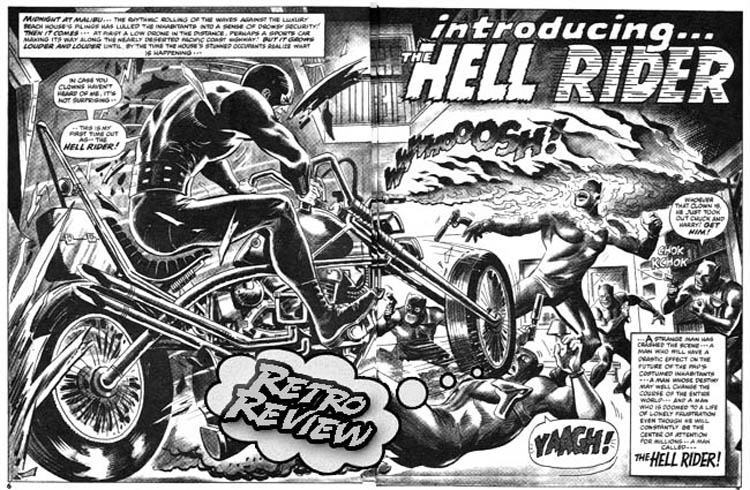
1 Comment
Wait, you mean they didn’t say, “Shades of Thunder Road” back in the day?
Kidding.
Maybe.
Listen, Bob Haney and his Teen Titans would have to “dig a crazy scene” in the 60’s, but we know everyone under 21 didn’t talk like that, right? Titles set in a certain decade don’t always reflect the period. Think about it, they had black characters rockin’ afros into the mid-80’s, a time when fades, jheri curls and shag cuts were in effect. Just have to go with the flow and enjoy the ride sometimes.